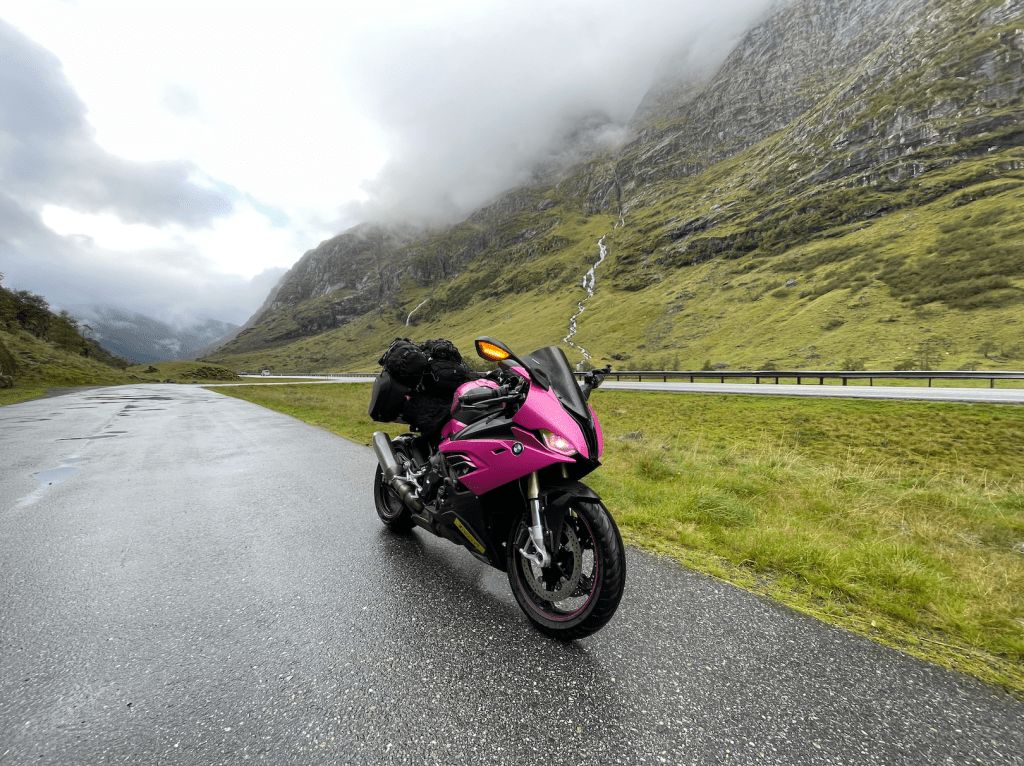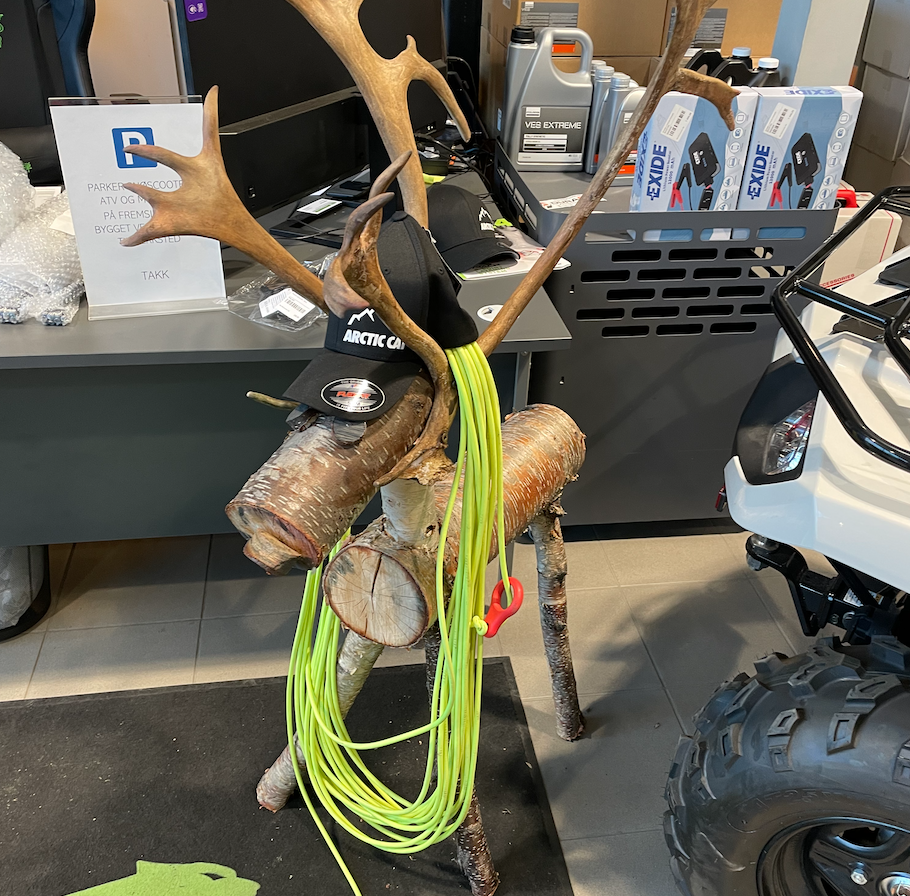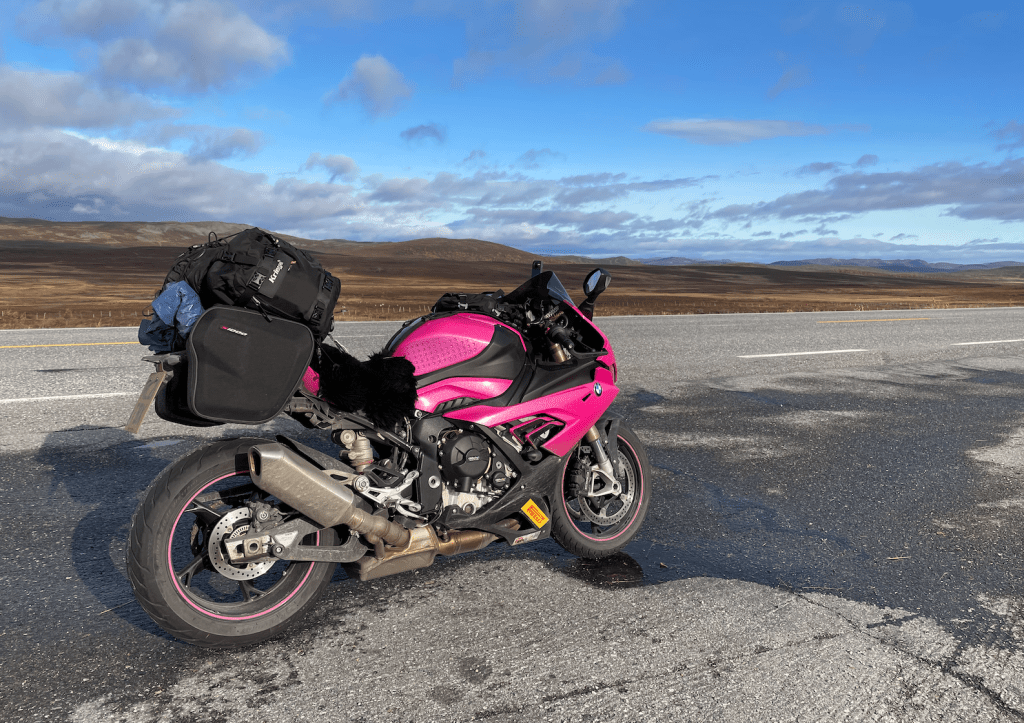At least twice now I’ve been asked how I manage to pack up my S1000RR, so I feel that warrants a blog post. How do you load up a sports bike for weeks or months of travel? I have limited knowledge but hopefully with what I do know, I can point you in the right direction and can say with confidence that it is possible to get what you need on a sports bike and you don’t need a GS to enjoy tent life.
My first experience with sports bike touring (with tent, I need a name for this… sports bike tent life?) was fairly early into my motorcycle journey, I had my Ninja 300 and went to France for a long weekend with some new friends, to camp and attend a classic motorcycle event. I was left to my own devices to purchase a tent, camping equipment and a method of getting the lot onto my little green bike. I went running to J&S to purchase the cheapest throw over panniers I could get my hands on, and then to SportsDirect for a tent that packed small enough to sit on my pillion seat. With an obscene amount of bungee cords I was able to secure everything I thought I needed onto the bike, fairly neatly.

It wouldn’t be particularly exciting to tell you that my £50 canvas panniers lasted nearly 10 years, went onto every bike I made them fit to (bungee cords, brute force, whatever it took…) and kept safe their contents, until a mysterious hole appeared in one after a long weekend on an SV650 of all things. You’d expect me to tell you that cheap panniers are useless, and follow that up with expensive recommendations, but deep down you want the budget friendly option to work – good news, it does. I took an R1 across Wales in endless rain, with a bin bag and bungees instead of proper luggage, and although it was a royal nightmare to access my belongings and it looked stupid, it worked.

So my first piece of advice – don’t Klarna your luggage* – you don’t need to. Buy what you can afford, work your way up.
The first most important thing about your luggage – it needs to stay on the bike. Ideally it shouldn’t wobble, it should be visibly level, about the same weight on either side, it shouldn’t touch your exhaust or cover your tail lights and indicators. Once loaded up, there should be enough room left on the bike for your to squeeze your butt on the seat and maybe even move around a little. With a sports bike, there is usually only a small pillion seat, and very rarely is there any anchor points. What sports bike owners usually do at the first opportunity upon purchasing said bike, is remove precious anchor points. Pillion pegs and massive tail tidies are extremely useful for touring, together they create the perfect set of anchor points for securing bungee cords, straps, anything – and you already hate the way they look, so it doesn’t matter if they get scratched up.

(Speaking of scratching up your poor bike, before you put anything on it, best protect its shiny delicate surfaces. There are several products you can purchase to put over sensitive spots – spongy luggage mesh/web is the best and can be bought cheaply, as can some soft foam postal packaging. Electrical tape can be wrapped round subframes, exhaust hangers etc.)

I’m going to mention bungee/rok straps a few times. I started with bungee cords and ended up with rok straps after many, many people told me I should be using rok straps instead of bungee cords. Both are great, bungee cords are simple, cheap and easy to get hold of, rok straps are more secure and effective for holding luggage in place.
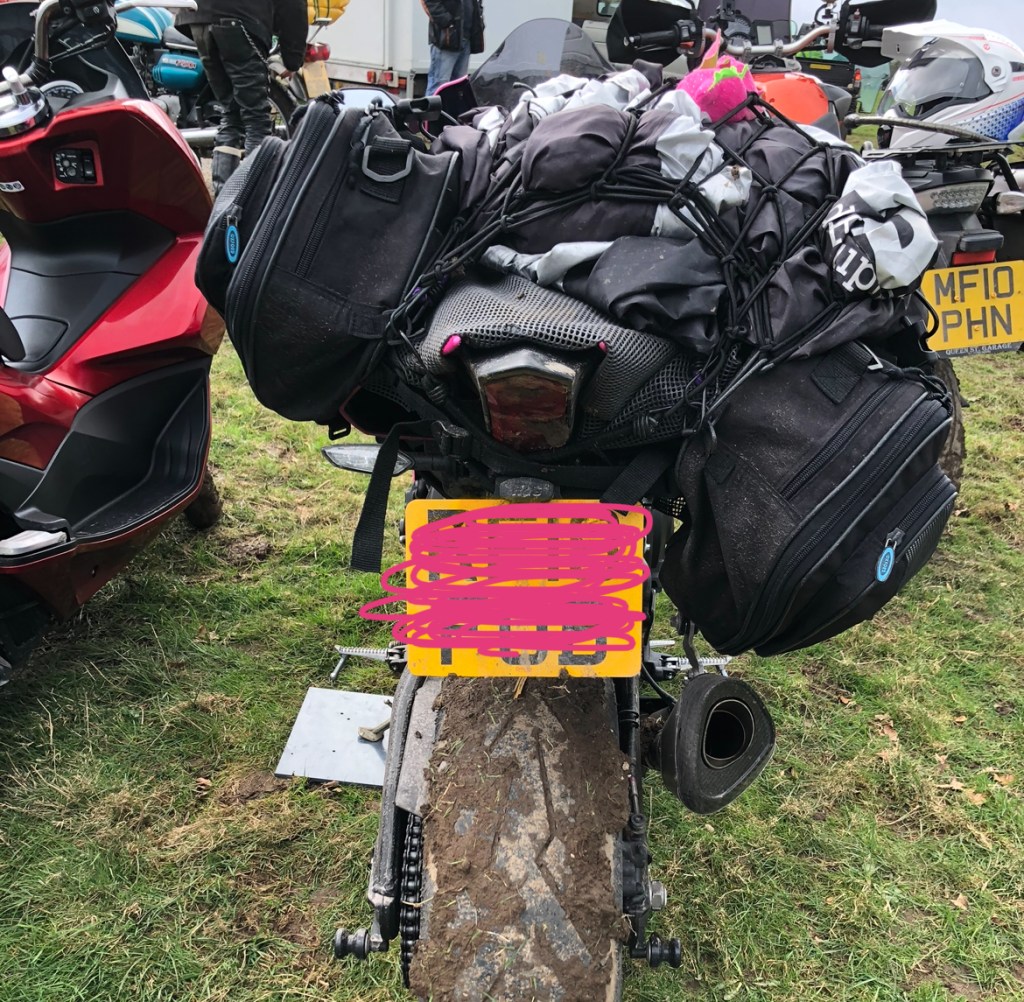
The second most important thing about your luggage – the things inside it shouldn’t get wet. That doesn’t mean your luggage needs to be waterproof, but it does help. Lots of luggage products out there aren’t waterproof, some come with waterproof outer covers, but what is probably more effective (than a bag cover flapping around in the wind…) is putting your belongings into a waterproof bag and putting that bag inside your outer luggage. Dry bags are a good investment, supermarket plastic carrier bags also work. A budget conscious motorcyclist knows that plastic carriers bags are a gift directly from God. If something gets wet, keep it away from your dry things, carry spare bags.
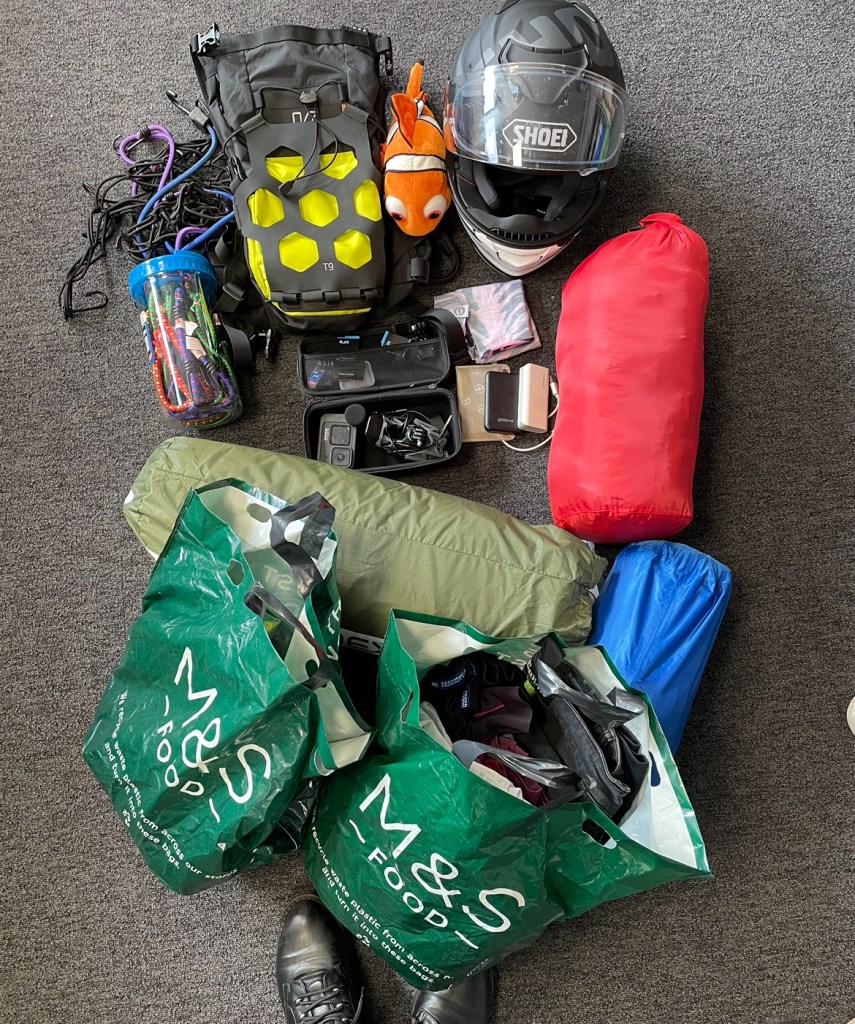
So, with these two things in mind, you need to find a set of panniers, or luggage solution that’ll fit most of your kit inside. Side panniers are fantastic because as well as providing a lot of storage, they widen your pillion seat so you can pile more stuff on top of it. Most manufacturers now produce bike-specific panniers, and so the panniers you see on my RR are straight from BMW. SW Motech make a very similar product, both brands fit the bike beautifully, are durable, and well designed. They aren’t cheap – around £350-£400, I imaging they’ll be a similar price for all bikes and it does mean if you buy a new bike you’ll have to buy new panniers. If you don’t want to fork out for this, or can’t find a specific product for your bike, there are a lot of generic options to choose from. Throw over panniers are exactly that, two bags connected by straps that you throw over your back seat, half straps go under the pillion seat fixture stopping it from shifting, half go over the top to pull them tight to the bike, and then you secure it firmly with additional straps/bungees – this works on everything with a back seat/cowl, a bit fiddly to fit but won’t give you any problems once it’s on. You can spend £50 to hundreds on throw over panniers and as I mentioned earlier, they can last years, just don’t let them hang near your exhaust.
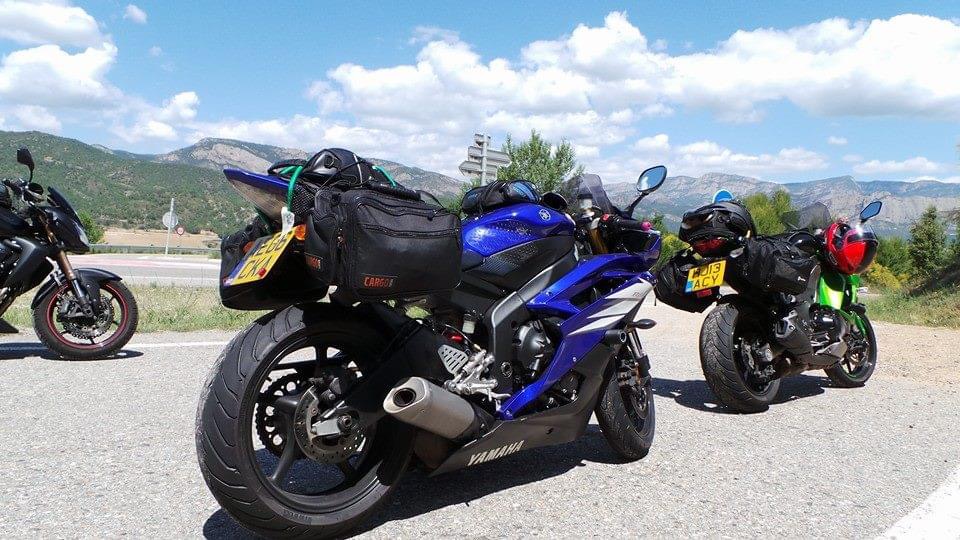
Once you have panniers, you have a much wider base for the rest of your luggage. I used my panniers for cooking equipment, half my clothes, and things I wouldn’t need regularly, or that I’d only need once I’d removed the things stored on top. Now you can fit a tail bag, roll bag, or – if you’ve got a massive tent – your tent. With a wider base you now have freedom to be creative with what you pack and how. Previously, when I used a much larger tent, I’d go for a pyramid shape – lie my tent across the back seat, put my clothes in a gym bag, and build a pyramid of these items along with sleeping bag and mattress, throw a tarp over the lot, and secure it with bungee straps and/or rok straps. This is a relatively easy and fail safe system, it’s also free. The downside of piling everything up like this is it can be awkward for one person to both balance the items onto the back seat while reaching about to secure it; if you’re in a group you can obviously help each other, if not, it can be frustrating but eventually will become a part of life – just make sure you carry plenty of spare straps/bungees because you’ll find things never go onto the bike the same way twice.

Currently, I use a Kreiga luggage system. My products of choice are the 30 litre dry bag, and two 10 litre dry bags attached to each side, which – once full – come out no wider than my panniers and fit beautifully. I can squeeze my tent and sleeping equipment into the 30ltr central bag, and my clothing into each 10ltr bags. The Kreiga US dry bags fit to any bike, including sports bikes, using a hook and loop system – you secure four loops under your pillion seat, and the bags attach to these hoops and tighten up so the bags don’t wobble and can’t fall off. The Kreiga bags are also completely waterproof. A system like this makes life much easier, you can remove your luggage from your bike and put it back on in one piece and pull items out without disturbing the rest of your belongings.

By this point, you should have been able to find a home on your bike for your large essential items – tent, sleeping bag, clothing, cook set, tools. I haven’t given any recommendations for tent/sleeping equipment yet. I started out with a tent from SportsDirect, this was a £35 tent, not awful, but it was big, it packed down big, and one year it was flattened by the wind, but it did a good job until then, so I wouldn’t want to discourage someone just starting out by saying you need to go out and spend £100 on a tent. If you can make your cheap festival tent fit on your bike – that’s an ok place to start.
For those curious – I currently have three tents, all from OEX which is a decent fairly budget friendly outdoor brand. My favourite tent at the moment is my OEX Phoxx ii vii, this is a two man tent – but they’d have to be two very skinny men. It’s perfect for one person, and their stuff. It packs down small enough to fit inside and take up only half of my Kreiga 30 Litre dry bag, and so it goes inside my luggage instead of on top. I also have a Phoxx i – the one man version, this packs even smaller but is extremely small to live in, and really only suitable for dry weather when they only time you need to be inside the tent is to sleep. My third tent is the OEX Jackal ii – this is much bigger, and my favourite tent to live in, it has room to sit up properly and spread out, and it has a porch so you can cook outside with a bit of shelter. Unfortunately the Jackal doesn’t pack up small enough to go inside my luggage, but it balances on the back seat nicely if I don’t use my Kriega system and instead revert to the pyramid. These are three good tents that cost from £80.00 to £200.00 depending on outlet and deals at the time – I’ve never paid full price for any – they’re always on offer somewhere.

There are better and more suitable tents out there, for a price, or maybe even cheaper if you do some digging. The one thing I will say, avoid paying hundreds for a tent that’s marketed towards motorcyclists – a lot of it is just that – marketing. Do a bit of research and buy a tent that packs small, goes up and down easily, and keeps water and moisture out. Your bike does not need its own tent garage (unless it’s constantly breaking and you need a home-from-home workshop in the evenings), you’ll end up carrying around twice as much tent so that an outdoor vehicle can have its own house. But if that appeals, go for it, I notice a lot of them and don’t understand why you’d want the extra faff. I would also feel very uncomfortable sleeping within falling distance of my bike.

I carry a cheap tarpaulin, and lay this down on the ground first and put my tent on top it it. It keeps the bottom of the tent clean and dry, provides a bit of insulation and cushion, and you can pull a bit out from under the tent and sit on it if you tent doesn’t have a porch. Normally I roll this up and wedge it above my number plate – or I use it to keep my luggage pyramid dry.
Sleeping bags, like tents, are subject to budget first, then space. I am currently using two sleeping bags, because two small bags pack up in a better shape than one big one – it fits my system perfectly, but what works for me won’t always work for someone else. My recommendation here is to measure how much space you can afford to give to a sleeping bag once everything else is on the bike, and get the best you can that fits into that space. You can purchase stuff sacks, so if your sleeping bag packs short and wide and your remaining space is long and thin – look to purchase a long thin stuff sack and keep your sleeping bag in that instead. Similarly, sleeping mats come in many sizes, see how much room you have left and get something compact. Pillows are a final thought, generally I just use my jacket and pants as a pillow – since they take up space anyway, I might as well use them.
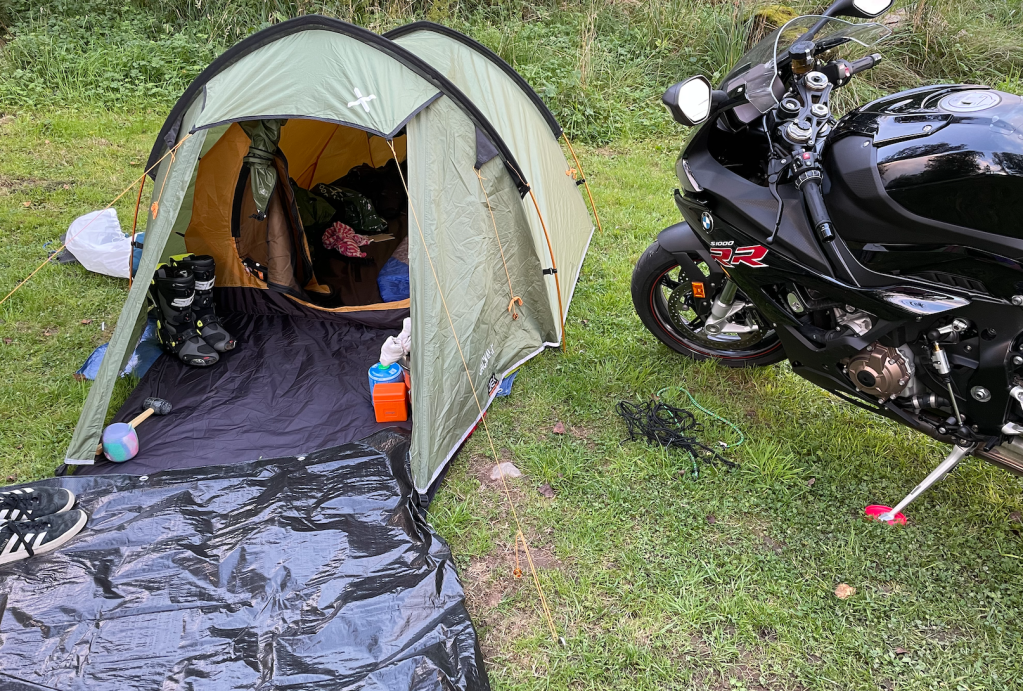
I don’t have recommendations at all for cooking equipment, I spent less than £50.00 on my camping cook set and stove – Decathlon or a similar physical shop is your friend. Take your panniers to the shop with you and make sure it’ll all fit. If you’re traveling with friends, collaborate to save space. If you’re planning to cook and eat outside, the very minimum you need is a stove and gas, a cooking tin – preferably a deep one that you can also eat out of, a knife and fork, mug or cup, a tiny bottle of washing up liquid and sponge, and a lighter. There’s a lot of fancy products out there but actually a pair of mess tins for £7.00 will do the job while you find your feet. You can attach a bungee net over the top of your tail luggage and wedge groceries in this on your way to your evening stop if you want to cook, but you might not have the room to carry ingredients around all the time, and when traveling alone it’s difficult to buy ingredients for one person for one meal – if you can, keep some space in your luggage and carry tupperware containers so you can keep leftovers to reheat (keep food items in their own plastic bag, or they’ll leak everywhere).
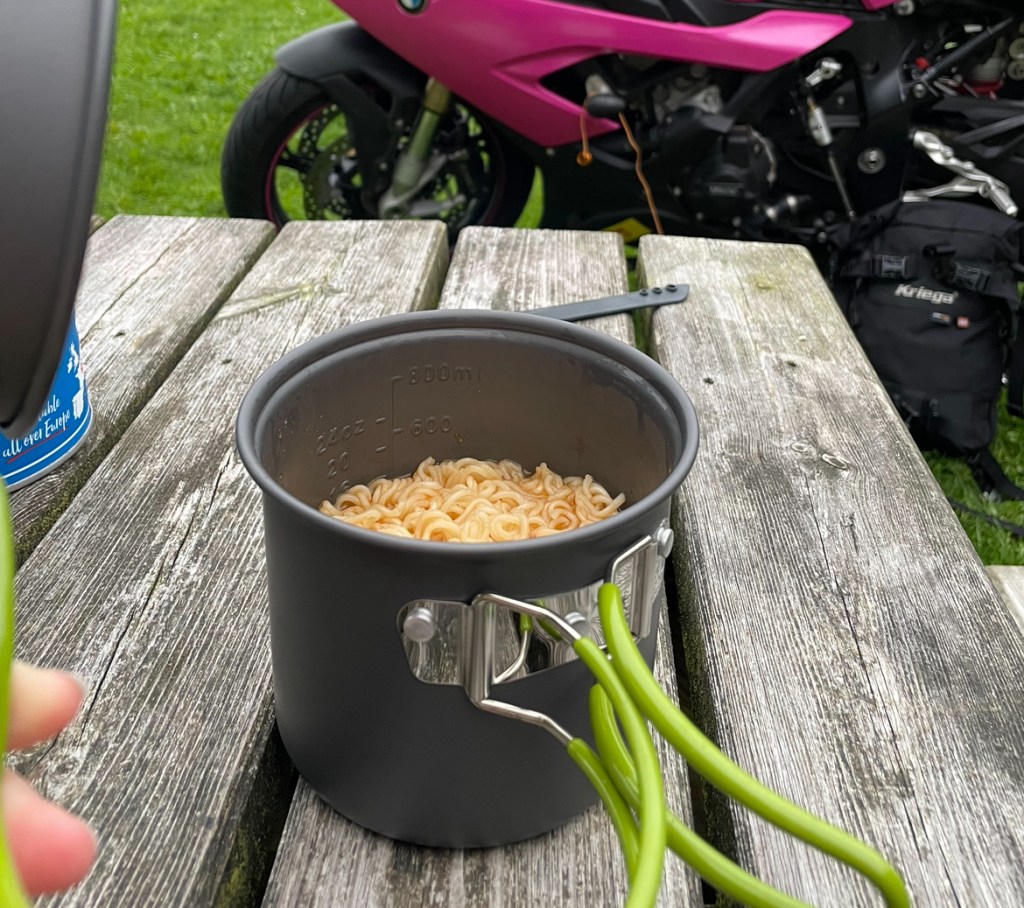
This should be your essentials, now loaded onto your bike! You have a few more places on a sports bike where you can store things. A tank bag is a great tool to keep items you need to access quickly, and there’s a lot of good options out there for tank bags. It used to be that you’d have a magnetic tank bag and one side fits basically everything, then, tanks were made out of plastic, or metal that magnets don’t stick to, and magnetic tank bags became useless (I should I know, I had the cutest little one that I had to stop using). The current popular tank bag solution is a bike specific tank ring, and bag that attaches to the ring. SW Motech and Givi do great products and there’s loads of bags to choose from – it is confusing though trying to figure out what fits what, if I were shopping, I’d go to a store and ask someone to work it all out for me. I had an SW Motech tank bag and fitting for my RR but swapped after a year for a Kreiga tank adapter and small dry bag. I swapped for several reasons – I liked the way to Kriega products looked, particularly matching the rest of my luggage, but also because I didn’t like the magnetic locking mechanism on the SW Motech product and worried that if it broke somehow, I wouldn’t be able to access my fuel cap. So the Kreiga one makes me feel a lot happier, because the whole thing comes away with the snap of a plastic clip when I need to fill up, it was also a good bit cheaper, and the bag is waterproof.
Finally, you may be tempted to wear a backpack. I use a waterproof backpack but I’m very strict about what goes in there – my passport, my phone charger and camera, that’s it. If you put too much in it you won’t be able to sit up and stretch your back out when you’ve got all your luggage on the back.
For power, and this is a problem specific to sports bikes, you’ll probably need a power bank. Yes you can fit a charger port to your bike, but sports bikes have itty bitty batteries so when you’re not riding you should avoid using it to charge your electronics. Amazon offers a wealth of power banks and for £30-£50 you can get a nice one that’ll charge your phone for about a week and fit into a backpack.

That’s it, that’s everything! It’s an unusual situation, to be touring with a sports bike, but it can be done, and it’s possible to do it cheaply until you find products you love that you want to invest in. We live in irritatingly expensive times, so resorting to plastic bags and bungees is an absolutely ok way to dip your toe into something new. I hope this blog has inspired or encouraged someone to give it a go, and think twice about swapping their beloved sports bike for a touring machine under the assumption that they need one to travel.

* don’t Klarna your luggage – unless you want to ❤ no judgement. This blog is for the budget conscious or for those wanting to try something without investing.






